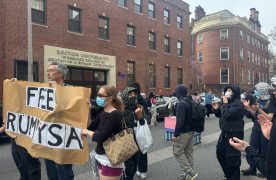Yesterday’s article titled ‘Boston unattractive to students after graduation, politicians say,’ paints an inaccurate portrait of the opportunities available to students educated in Boston upon graduation.’ Unfortunately, the blanket assertions made by representatives of Michael Flaherty and Sam Yoon go nearly unchallenged, and the statistics cited don’t tell the full story.
In truth, Boston remains a very young city, one whose population has continued to grow recently.’ One-third of Boston’s population is comprised of 20-34 year olds ‘- the second highest concentration of any major city in the U.S. ‘- and Boston’s overall population continues to grow, surpassing 600,000 people for the first time since the 1970s.
As the article rightfully points out, Mayor Menino underscored the importance of post-graduate opportunities for young adults when he launched ‘One in 3 Boston’ to connect this demographic with resources related to business development, professional networking, home buying and civic engagement.’ But you don’t only have to take the mayor’s word for it.’ Forbes magazine recently ranked Boston a Top Five city for young professionals, and in a September 30 article, The Wall Street Journal ranked Boston among the Top 10 Next Youth Magnet Cities.
The Wall Street Journal went on to say, ‘Boston is a world center of management consulting, with strong financial-services and high-tech sectors, and unemployment is relatively low at 8.9%.” Under Menino’s leadership, Boston continues to attract jobs and economic growth, with five million square feet of projects under active development and another 30 million square feet in the pipeline.’ To put these numbers in context, the Prudential Center is about one million square feet.’ So, these statistics represent a staggering amount of growth, especially when so many other major cities have felt far worse effects from the global recession.
Boston’s creative industries are strong and expanding, emphasized by respected companies like Mullen Advertising recently relocating to Boston.’ Furthermore, the emerging life sciences sector has also found a home in Boston, with Mayor Menino welcoming two new biotech firms ‘- Ginkgo BioWorks and Eutropics Pharmaceuticals ‘- to the city just weeks ago.’ The Milken Institute, an independent economic think tank, ranked Boston as the #1 life sciences cluster in the country.
Despite his unsuccessful attempts to paint Boston as a city that doesn’t work for students and young professionals, what Michael Flaherty fails to convey is his willingness to increase costs for students and the colleges and universities that are such great assets to our city.’ In an interview with The Daily Free Press, Mr. Flaherty called on schools to provide a ‘consistent dedicated revenue stream’ in the form of Payment-in-Lieu-of-Taxes (PILOT), a cost that would presumably be passed onto the students that already bear a high burden in the form of tuition.
Conversely, Mayor Menino, through a PILOT task force, is seeking to create equitable agreements among tax-exempt institutions, rather than simply looking to them as an expedient source of revenue.
Let’s acknowledge the allegations of the mayoral hopeful and his would-be deputy for what they are ‘- political pandering.’ In the end, while yesterday’s article claims that ‘politicians’ say Boston is unattractive for students after graduation, the only two political perspectives given are from representatives campaigning against Mayor Menino.’ Not the most objective voices in this discussion, I would argue.
This is an account occasionally used by the Daily Free Press editors to post archived posts from previous iterations of the site or otherwise for special circumstance publications. See authorship info on the byline at the top of the page.














Ahhhh, who the fuck wrote this?!